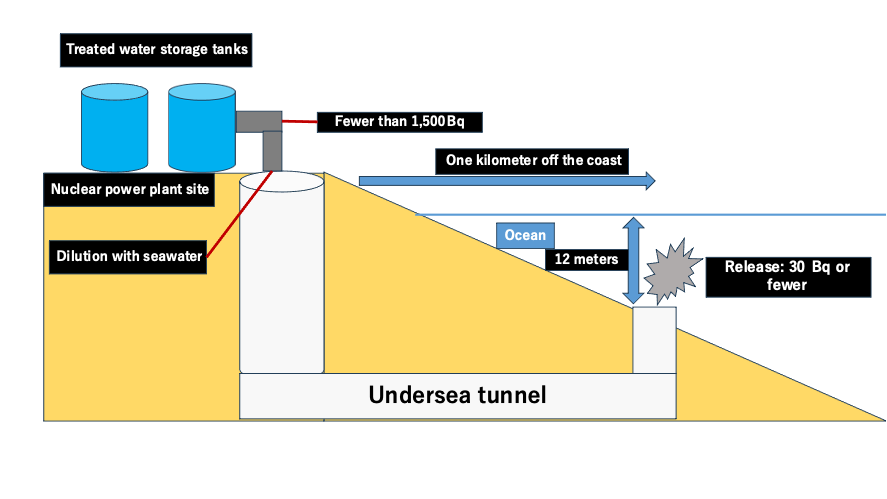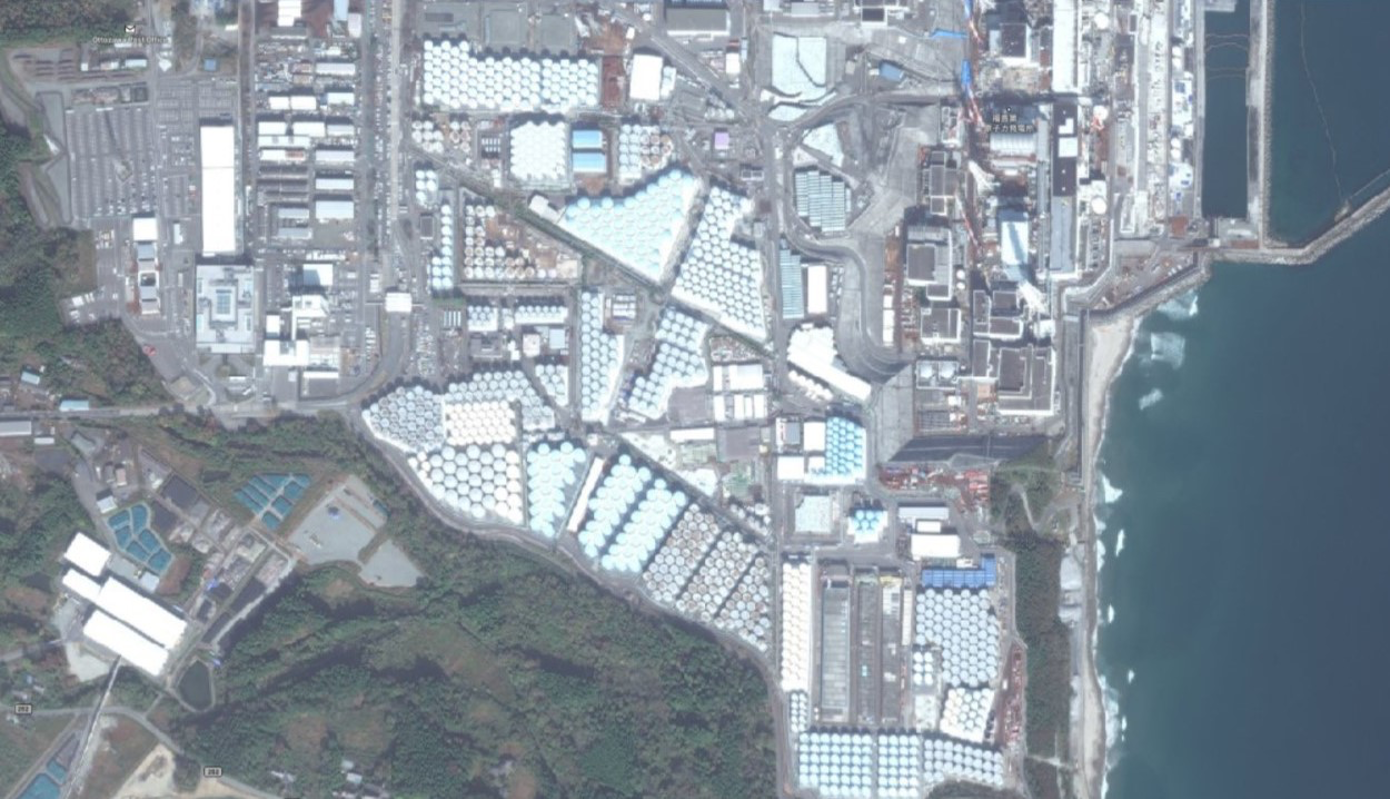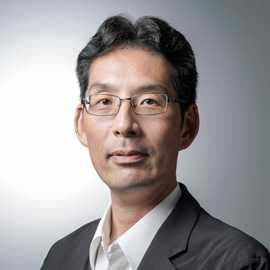1. Toward the commencement of release of “treated water”
Twelve years have passed since the Fukushima Daiichi Nuclear Power Station accident, and the government decided to commence the ocean release of “treated water” on August 24. Water is injected in order to cool nuclear fuel and then the contaminated water is purified using dedicated equipment to produce treated water. The treated water is put into tanks and stored on site at the nuclear power plant. The authorities will begin the release because the vacant land at the nuclear power plant will be fully filled up with tanks by spring 2024.[1]
The treated water contains tritium, a radioactive material, but this cannot be removed even with the dedicated equipment. Depending on the amount ingested, it is known to have effects on the human body such as a reduction in blood cell components,[2] but nuclear facilities in countries around the world are releasing treated water into the natural world, including the ocean, after diluting it to the extent that it has no effect on the human body or the environment. In accordance with this standard practice, the policy regarding the treated water of the Fukushima Daiichi Nuclear Power Station is to dilute its concentration to less than approximately one fortieth of the national government’s standard (1,500 Bq/liter[3] ) and dispose of it over several decades.
The decision of the Japanese government has not necessarily gained the understanding in Japan or overseas. Japanese fishery managers, especially those led by the Fukushima Prefectural Federation of Fisheries Co-operative Associations, who have been suffering reputational damage, have consistently opposed the ocean release of the treated water,[4] and in addition China is calling on the Republic of Korea (ROK) and the Pacific island countries to join with it to fight against the release, telling them “do not allow the radioactive contamination of the ocean.” The treated water release will take more than 30 years, so it is necessary for the Japanese government to prepare a strategy to ensure Japan does not lose credibility as a nation, rather than just temporary measures.
In this paper, we present an overview of the developments in the treated water problem after the Fukushima Daiichi Nuclear Power Station accident, and consider ways to implement the ocean release appropriately over the long term.
2. The current status of the treated water and domestic and overseas moves with respect to its ocean release
(1) Overview of the treated water release plan
At the Fukushima Daiichi Nuclear Power Station, it is necessary to circulate large quantities of water in order to cool the nuclear fuel which melted down due to the accident (debris). As a result, approximately 90 tons of contaminated water containing radioactive materials are generated per day, the radioactive materials are removed to a level below the national government’s standard value using dedicated equipment called the Advanced Liquid Processing System (ALPS), and the treated water is stored in tanks on the site. As of July 31, 2023, there are 1,073 storage tanks, the stored amount has exceeded 1,300,000 tons, and the storage rate has exceeded 98%. There is no more vacant land inside the nuclear power station site, so the national government has decided to build an undersea tunnel to release the diluted treated water one kilometer off the coast from the nuclear power plant site (refer to Figure 1).

On July 4, the Director General of the International Atomic Energy Agency (IAEA), Rafael Grossi, submitted the Comprehensive Report of the Task Force on ALPS treated water, which was independently established in the IAEA, to Prime Minister Fumio Kishida and communicated the evaluation results regarding this plan that “the ocean release is consistent with international safety standards.”[5] On July 7, the Nuclear Regulation Authority also granted a “pass certificate” to the plan to release the treated water off the coast using an undersea tunnel and put in place a structure to enable the government to implement the treated water release at its own discretion.[6]

(2) TEPCO, which has lost its capacity to solve the problem on its own, and the backlash from neighboring countries
The main events leading up to the treated water release are introduced in Table 1, and the event which had the biggest effect was Tokyo Electric Power Company (TEPCO) releasing low-concentration contaminated water into the ocean as an emergency measure immediately after the accident in 2011. The affected people were not sufficiently informed in advance, so this action invited a lot of criticism from inside and outside Japan.[7] As a result, TEPCO lost its capacity to solve the problem on its own and the national government was forced to respond to the situation.
Table 1: Events concerning the disposal of contaminated water
| Date | Measures | Objectives and results |
|---|---|---|
| April 4 to April 10, 2011 | TEPCO released low concentration contaminated groundwater into the ocean | TEPCO was forced to release low concentration contaminated water into the ocean in order to secure reservoirs so that highly contaminated water would not leak into the ocean, but the affected people were not sufficiently informed in advance, so there was criticism from not only local residents but also neighboring countries |
| From March 2013 | The Advanced Liquid Processing System (ALPS) for purifying contaminated water commenced operation | The ALPS is considered to have the ability to remove all radioactive materials except tritium, but cases have also occurred in which it could not remove all of those radioactive materials |
| May 13, 2013 | The Fukushima Prefectural Federation of Fisheries Co-operative Associations expressed opposition to the proposal of TEPCO to release pumped up groundwater into the ocean in order to develop a groundwater bypass | In response to voices saying “there will be no trust from fisheries cooperatives if it is proposed by TEPCO alone. We seek explanations in terms of the policy of the national government,” subsequent explanations to the community were given jointly with the Ministry of Economy, Trade and Industry |
| September 8, 2013 | In the International Olympic Committee Session at which he was aiming to win the bid to host the Tokyo Olympics, (then) Prime Minister Shinzo Abe gave a speech about the contaminated water in which he stated that the “situation is under control” | His objective was to dispel the concerns of the international community regarding ocean contamination |
| November 2016 | The Ministry of Economy, Trade and Industry established the Subcommittee on Handling of the ALPS Treated Water | Its purpose was to discuss solutions for contaminated water treatment from a third party perspective |
| September 2018 | TEPCO had been explaining that ALPS “could remove all radioactive materials other than tritium” but then announced that there are other materials which cannot be removed and which are higher than the standard value | Initially this was only announced on the website of TEPCO, so there was criticism of the company’s attitude to information disclosure |
| August 2019 | TEPCO declared that it expected “the vacant land inside the Fukushima Daiichi Nuclear Power Station to be filled to capacity with water storage tanks by about the summer of 2022” | The final disposal of water treated using the ALPS became an urgent issue |
| February 2020 | The subcommittee published its report | Its conclusion was that ocean release is the best approach |
| April 2021 | China objected to the ocean release of the treated water and intensified its criticism of Japan | The ocean release has become an issue that affects Japan’s international reputation |
| July 2023 | The IAEA submitted the Comprehensive Report concerning ALPS treated water to Prime Minister Fumio Kishida | Its conclusion was that the “ocean release of ALPS treated water is consistent with international safety standards” |
Source: Prepared by this author with reference to the TEPCO website and other sources
China in particular strengthened its criticism regarding the treated water problem and it has been intensifying its criticism of Japan since April 2021. In that same month, Zhao Lijian, (then) Deputy Director-General of the Information Department in the Ministry of Foreign Affairs of China (Spokesperson) stated in a press conference that “the oceans are not Japan's trash can, and the Pacific Ocean is not Japan's sewer.” Zhao also posted to his own Twitter account a caricature with a ukiyo-e print by Hokusai Katsushika, Thirty-six Views of Mount Fuji: Under the Wave off Kanagawa, as the motif, which replaced Mt. Fuji with a nuclear power plant and portrayed people wearing protective clothing using buckets to pour a liquid from their boat into the sea.[8] Moreover, it has called on the Pacific island countries, which are becoming the main battleground in its struggle for supremacy with the United States, to also join it in the fight against the treated water release problem.[9]。
3. The response of Japan
(1) Scientific “proof of safety” and its limitations
In response to these developments, Japan firstly attempted to prove the safety of the treated water release using science verification by third parties. This was because the half-life of tritium, the period in which its radioactive isotopes reduce by half, is 12.33 years, a short life compared to other radioactive nuclides, and even if it enters a human body it is extremely rare for internal exposure to occur, so Japan judged that it could obtain understanding for the ocean release if the tritium was at or below the standard value.
Japan’s specific method was to seek the cooperation of the IAEA. In April 2021, a task force comprised of specialists from 11 countries, including China, was established in the IAEA, and it submitted the aforementioned Comprehensive Report to Prime Minister Kishida this year.[10]Furthermore, the task force has repeatedly stated that the total amount of tritium contained in the more than 1,300,000 tons of treated water currently stored in tanks is a little less than a mere 20 grams, [11] and the total amount of radioactive material anticipated annually as a consequence of the release is at a low level compared to the nuclear facilities of other countries, including China (refer to Table 2).
Table 2: The total amount of tritium discharged from the nuclear facilities of various countries
| Country | Facility | Discharged amount | Base year |
|---|---|---|---|
| Japan | Fukushima Daiichi Nuclear Power Station | 22 trillion Bq | 2023 onwards |
| South Korea | Wolsong Nuclear Power Plant | 23 trillion Bq | 2016 |
| China | Qinshan Phase III Nuclear Power Station | 143 trillion Bq | 2020 |
| United States | Callaway Nuclear Generating Station | 42 trillion Bq | 2002 |
| Canada | Darlington Nuclear Generating Station | 241 trillion Bq | 2015 |
| France | La Hague nuclear fuel reprocessing plant | 13.7 quadrillion Bq | 2015 |
Source: Prepared by this author by compiling the latest data of each country with reference to the website of the Federation of Electric Power Companies of Japan and other sources.
(2) Responding to information warfare with dialogue and diplomacy
Nonetheless, proof of “safety” using science did not lead to the provision of psychological “peace of mind” and in Japan voices complaining that reputational damage was expected to occur due to the treated water release were unceasing, and led by the fishery operators in Fukushima Prefecture and its neighboring prefectures.[12]Exploiting a gap between “safety” and “peace of mind,” China repeatedly made appeals to international public opinion implying that the release of the treated water would lead directly to ocean contamination.
The Japanese government launched full-scale “measures to win over international public opinion” from the beginning of 2023. Firstly, it dispatched Minister for Foreign Affairs Yoshimasa Hayashi as a special envoy to deliver official letters from Prime Minister Kishida to 14 Pacific island countries, and the foreign minister visited 13 countries, excluding Kiribati, to hand over the official letters and directly explain the safety of the treated water release.[13]
The Japanese government also aimed to win over the ROK, taking advantage of improved relations resulting from the change in administration in the ROK. In the Summit Meeting with President Yoon Suk Yeol in May, Prime Minister Kishida accepted the inspection of the Fukushima Daiichi Nuclear Power Station by ROK experts which had been sought by the ROK side.[14] The inspection was implemented on May 22 to May 26 with the objective of “fostering understanding in the ROK of the ALPS treated water release” (according to the Ministry of Foreign Affairs of Japan).[15]
4. Japan should establish a strategy prepared for a prolonged battle
The diplomacy is producing some results. For example, President Whipps of Palau visited Fukushima in June, and declared that he trusted the response of Japan concerning the ALPS treated water.[16]However, this degree of diplomatic success will not make China back down. In June, China’s ambassador to the ROK invited Lee Jae-myung, the leader of the ROK’s largest opposition party, the Democratic Party of Korea, to the ambassador’s residence in Seoul and they reached agreement on cooperating to stop the ocean release.[17]It appears that China’s aim is to shake the resolve of President Yoon, who is cooperative toward Japan, by collaborating with the largest opposition party. Moreover, China strengthened import quarantines on food ingredients from Japan, including marine products, in July as it tries to curb Japan’s moves to carry out the ocean release.[18]
The ocean release of ALPS treated water will take more than 30 years. Whether or not Japan will be able to implement the ocean release appropriately will affect not only the prevention of reputational damage but also Japan’s credibility as a nation. For that reason, it is necessary for Japan to prepare for a prolonged battle and for the whole government to collaborate on the response. Japan must learn the lessons from the past when delays in the transmission of information and the lack of prior explanations invited a harsh backlash from inside and outside Japan. Specifically, Japan should perhaps consider establishing an office for handling measures concerning the ALPS treated water in the National Security Secretariat in the Cabinet Secretariat, and invite experts in communication to work in that office, in order to ensure that the relevant government ministries and agencies can hold discussions on situational analyses and response measures at all times.[19]
(2023/09/08)
Notes
- 1 TEPCO website, “ALPS Treated Water, etc. Conditions”.
- 2 Japanese Radiation Research Society, “Health Effects of Tritium,” December 2019, pp. 10-11.
- 3 “Bq” stands for becquerels, a unit which expresses the ability of a radioactive material to emit ionizing radiation. The unit expressing the effect on the human body when exposed to ionizing radiation is called the sievert. Hokuriku Electric Power Company website, “About the Units of Ionizing Radiation and Radioactivity”
- 4 National Federation of Fisheries Cooperative Associations (ZENGYOREN), “Special Resolution on the Policy of Releasing ALPS Treated Water into the Ocean,” June 22, 2023.
- 5 IAEA, “IAEA Finds Japan’s Plans to Release Treated Water into the Sea at Fukushima Consistent with International Safety Standards,” July 4, 2023.
- 6 Nuclear Regulation Authority, “Specified Nuclear Facilities Inspection Implementation Procedures (Pre-Use Inspection),” July 7, 2023.
- 7 Sasakawa Peace Foundation, “Trustworthiness of Nuclear Energy Questioned: 10 Years after the Fukushima Daiichi Nuclear Accident,” May 2021, pp. 32-33.
- 8 Ministry of Foreign Affairs of Japan, “Press Conference by Foreign Press Secretary YOSHIDA Tomoyuki,” April 28, 2021
- 9 Embassy of Japan in China, “Q&As Concerning Treated Water,” May 24, 2021.
- 10 Refer to footnote 5.
- 11 The Denki Shimbun, “Basic Q&A about Tritium.”
- 12 Refer to footnote 4.
- 13 For example, “Extraordinary Press Conference by Foreign Minister HAYASHI Yoshimasa” (Cook Islands), March 20, 2023.
- 14 Ministry of Foreign Affairs of Japan, “Japan-ROK Summit Meeting,” May 7, 2023.
- 15 Ministry of Foreign Affairs of Japan, “Dispatch of the delegation of Republic of Korea (ROK) experts on the Current Status of Advanced Liquid Processing System (ALPS) Treated Water at TEPCO’s Fukushima Daiichi Nuclear Power Station (FDNPS),” May 25, 2023.
- 16 Ministry of Foreign Affairs of Japan, “Courtesy Call on H.E. Mr. Surangel S. WHIPPS, Jr., President of the Republic of Palau by Minister for Foreign Affairs Hayashi,” June 14, 2023.
- 17 Sankei Shimbun, “China and the Opposition Party in the ROK Join Forces to Condemn the Fukushima Treated Water Release, Say Japan is Turning the Pacific Ocean into a Sewer,” June 9, 2023.
- 18 JETRO Biz News, “Reports that Chinese Customs has Already Strengthened its Inspections of Japan-Made Imported Food Products,” July 27, 2023.
- 19 The Sasakawa Peace Foundation Ocean Policy Research Institute (OPRI) and Security Studies Program are compiling urgent recommendations for the Japanese government concerning the ocean release of ALPS treated water and will publish them soon.

